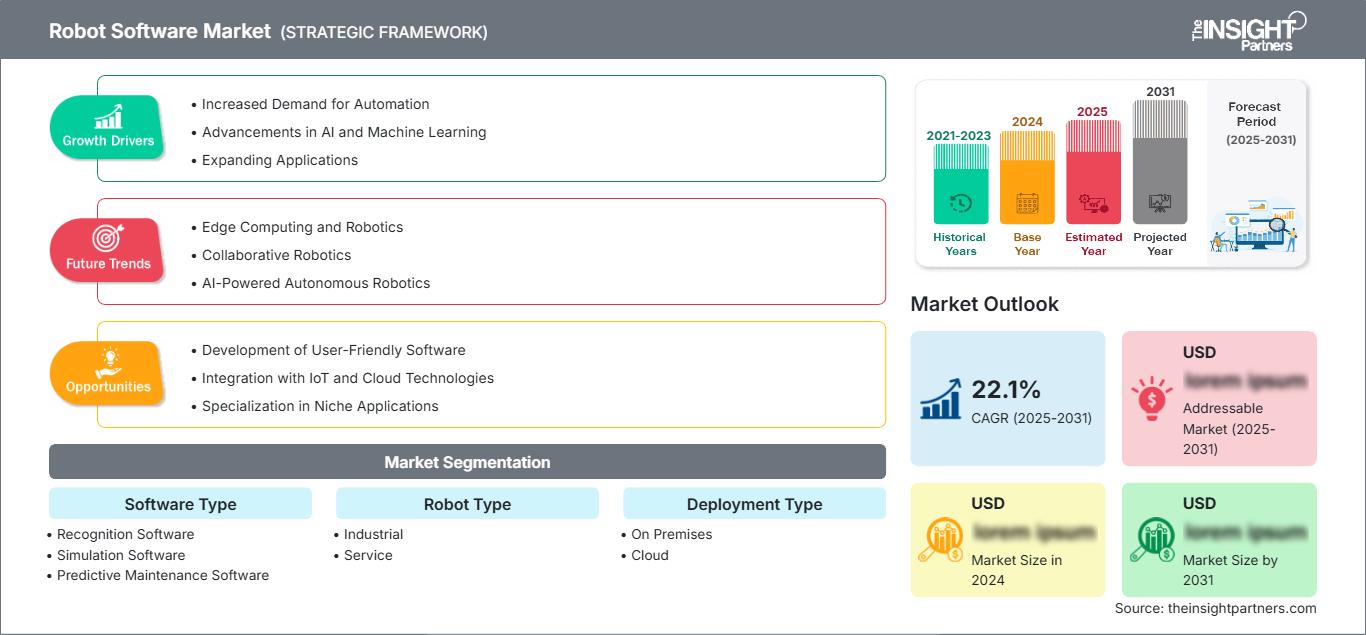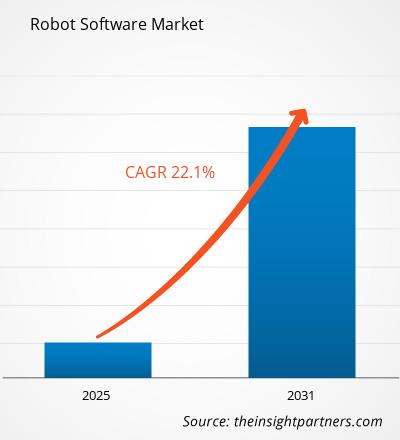ロボットソフトウェア市場は、2025年から2031年にかけて22.1%のCAGRで成長し、市場規模は2024年のXX百万米ドルから2031年にはXX百万米ドルに拡大すると予想されています。
レポートは、ソフトウェアタイプ(認識ソフトウェア、シミュレーションソフトウェア、予知保全ソフトウェア、データ管理および分析ソフトウェア、通信管理ソフトウェア)、ロボットタイプ(産業用、サービス用)、導入タイプ(オンプレミス、クラウド)、組織規模(大企業、中小企業)に基づいてセグメント化されています。グローバル分析は、地域レベルと主要国でさらに細分化されています。グローバル分析は、地域レベルと主要国でさらに細分化されています。上記のセグメント分析のため、市場評価は米ドルで提示されています。
レポートの目的
The Insight Partnersによるロボットソフトウェア市場のレポートは、現在の状況と将来の成長、主な推進要因、課題、および機会を説明することを目的としています。これにより、次のようなさまざまなビジネス関係者に洞察が提供されます。
- テクノロジープロバイダー/メーカー: 進化する市場のダイナミクスを理解し、潜在的な成長機会を把握して、情報に基づいた戦略的決定を下せるようにします。
- 投資家: 市場の成長率、市場の財務予測、バリューチェーン全体に存在する機会に関する包括的なトレンド分析を実施します。
- 規制機関: 乱用を最小限に抑え、投資家の信頼と信用を維持し、市場の完全性と安定性を維持することを目的として、市場におけるポリシーと警察活動を規制します。
ロボットソフトウェア市場のセグメンテーション ソフトウェアタイプ
- 認識ソフトウェア
- シミュレーションソフトウェア
- 予知保全ソフトウェア
- データ管理および分析ソフトウェア
- 通信管理ソフトウェア
ロボットタイプ
- 産業用
- サービス
導入タイプ
- オンプレミス
- クラウド
組織規模
- 大企業
- 中小企業
レポートの一部、国レベルの分析、Excelデータパックなどを含め、スタートアップ&大学向けに特別オファーや割引もご利用いただけます(無償)
ロボットソフトウェア市場: 戦略的洞察

- このレポートの主要な市場動向を入手してください。この無料サンプルには、市場動向から見積もりや予測に至るまでのデータ分析が含まれます。
ロボットソフトウェア市場の成長要因
- 自動化の需要増加:業界全体で効率性、生産性、コスト削減のニーズが高まっており、ロボットソリューションの導入が進んでいます。
- AIと機械学習の進歩:AIとML技術の統合により、ロボットはより正確かつインテリジェントに複雑なタスクを実行できるようになります。
- 用途の拡大:製造、医療、物流、農業などの分野でロボットの用途が拡大していることが、市場の成長を牽引しています。
ロボットソフトウェア市場の今後の動向
- エッジコンピューティングとロボティクス:エッジコンピューティングは、ロボットによるリアルタイムのデータ処理と意思決定を可能にし、レイテンシを削減し、パフォーマンスを向上させます。
- 協働ロボティクス:協働ロボット(「コボット」)は、人間と一緒に作業するように設計されており、生産性と安全性を高めます。
- AI 搭載自律ロボット:AI 搭載自律ロボットは複雑な環境をナビゲートし、自律的な意思決定を行う能力を備えているため、潜在的な用途が拡大しています。
ロボット ソフトウェア市場の機会
- ユーザーフレンドリーなソフトウェアの開発:ユーザーフレンドリーなソフトウェア ソリューションの開発により、ロボットのプログラミングと導入が簡素化され、より幅広いユーザーが利用できるようになります。
- IoT およびクラウド テクノロジーとの統合:ロボットと IoT およびクラウド テクノロジーの統合により、リモート監視、制御、データ分析が可能になります。
- ニッチ アプリケーションへの特化:特定の業界やアプリケーション向けのロボット ソフトウェアの特化により、イノベーションと成長の新たな機会が生まれます。
ロボットソフトウェア市場
予測期間全体を通してロボットソフトウェア市場に影響を与える地域的なトレンドと要因については、The Insight Partnersのアナリストが詳細に解説しています。このセクションでは、北米、ヨーロッパ、アジア太平洋、中東・アフリカ、中南米におけるロボットソフトウェア市場のセグメントと地域についても解説します。
ロボットソフトウェア市場レポートの範囲
| レポート属性 | 詳細 |
|---|---|
| の市場規模 2024 | US$ XX million |
| 市場規模別 2031 | US$ XX Million |
| 世界的なCAGR (2025 - 2031) | 22.1% |
| 過去データ | 2021-2023 |
| 予測期間 | 2025-2031 |
| 対象セグメント |
By ソフトウェアの種類
|
| 対象地域と国 | 北米
|
| 市場リーダーと主要企業の概要 |
|
ロボットソフトウェア市場のプレーヤー密度:ビジネスダイナミクスへの影響を理解する
ロボットソフトウェア市場は、消費者の嗜好の変化、技術の進歩、製品の利点に対する認知度の高まりといった要因により、エンドユーザーの需要が高まり、急速に成長しています。需要が高まるにつれ、企業は製品ラインナップの拡充、消費者ニーズへの対応、そして新たなトレンドの活用を進めており、これが市場の成長をさらに加速させています。

- 入手 ロボットソフトウェア市場 主要プレーヤーの概要
主なセールスポイント
- 包括的な調査範囲:本レポートは、ロボットソフトウェア市場における製品、サービス、タイプ、エンドユーザーの分析を包括的に網羅し、包括的な展望を提供しています。
- 専門家による分析:本レポートは、業界の専門家とアナリストの深い理解に基づいて作成されています。
- 最新情報:本レポートは、最新の情報とデータトレンドを網羅しているため、ビジネスの関連性を保証します。
- カスタマイズオプション:本レポートは、特定のクライアントの要件に対応し、ビジネス戦略に適切に適合するようにカスタマイズできます。
したがって、ロボットソフトウェア市場に関する調査レポートは、業界のシナリオと成長の見通しを解読し理解するための先導役となります。いくつかの正当な懸念事項があるかもしれませんが、本レポートの全体的なメリットは、デメリットを上回る傾向があります。
- 過去2年間の分析、基準年、CAGRによる予測(7年間)
- PEST分析とSWOT分析
- 市場規模価値/数量 - 世界、地域、国
- 業界と競争環境
- Excel データセット
最新レポート
関連レポート
お客様の声
購入理由
- 情報に基づいた意思決定
- 市場動向の理解
- 競合分析
- 顧客インサイト
- 市場予測
- リスク軽減
- 戦略計画
- 投資の正当性
- 新興市場の特定
- マーケティング戦略の強化
- 業務効率の向上
- 規制動向への対応




















 無料サンプルを入手 - ロボットソフトウェア市場
無料サンプルを入手 - ロボットソフトウェア市場